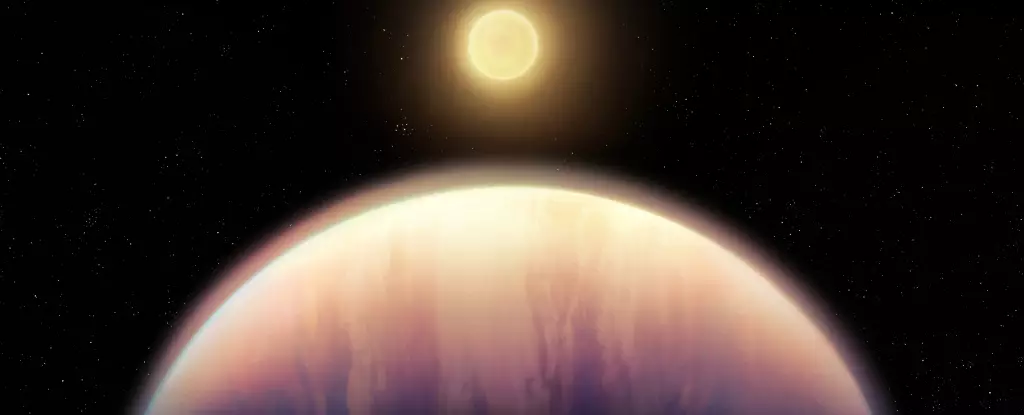In a remarkable development for astrobiology and planetary science, the James Webb Space Telescope (JWST) has pushed the boundaries of our understanding of exoplanets, particularly in how we analyze their atmospheres. This groundbreaking space observatory has harnessed its cutting-edge technology to detect carbon dioxide and other elements in the atmospheres of distant worlds, revealing valuable insights into the formation and evolution of planetary systems beyond our own. This leap into the cosmos not only highlights the capabilities of JWST but transforms our comprehension of where we stand in the universe.
The HR 8799 System: A Glimpse into a Distant Solar System
Located approximately 130 light-years from Earth in the constellation Pegasus, HR 8799 is an intriguing planetary system characterized by its young and vibrant main-sequence star, which boasts about 1.5 times the mass of our Sun. What sets HR 8799 apart is its status as one of the first planetary systems where multiple giant planets were directly imaged. These four gas giants—designated HR 8799 b, HR 8799 c, HR 8799 d, and HR 8799 e—are massive, ranging from five to ten times the mass of Jupiter. Their existence challenges preconceived notions about planetary formation and raises questions about the similarities and differences between this system and our Solar System.
The relatively close proximity of HR 8799 allows astronomers to conduct high-resolution studies, leading to ideas about how different planetary systems might have formed. By analyzing the light filtered through the gas enveloping these exoplanets, researchers can identify the chemical compositions of their atmospheres in impressive detail. This technique adds layers of depth to exoplanet studies, making it possible to decipher the histories encapsulated in distant worlds.
Insights into Planetary Formation
The discoveries made via JWST also contribute to the ongoing debate surrounding the processes behind planetary formation. There are generally two dominant theories: core accretion and disk instability. Core accretion involves solid cores of heavier elements attracting gas slowly over millions of years, much like the conventional model for forming gas giants in our own Solar System. On the other hand, disk instability suggests that massive gas clumps can form rapidly from the remnants of a cooling protoplanetary disk. Understanding which model predominates can reshape our perceptions of how different planetary systems evolve.
The Webb observations around HR 8799 provide compelling evidence implying that core accretion played a significant role in building these gas giants. The high levels of carbon dioxide found in the atmospheres of the planets reinforce the notion that they underwent processes resembling those believed to have shaped Jupiter and Saturn. This finding not only enhances scientific knowledge but allows for a comparative analysis of varying planetary systems scattered throughout our galaxy.
The Technological Marvel of JWST
What underlies these profound discoveries is the sophisticated technology encapsulated in JWST, particularly its NIRCam coronagraph system. This innovative instrument enables scientists to block the overwhelming brightness of nearby stars, revealing the faint infrared signatures emitted by their planetary companions. The ability to directly image exoplanets and analyze their atmospheric compositions is a feat that was previously deemed almost impossible, given the stark contrast in brightness between planets and their parent stars.
JWST has rapidly become the leading space observatory in the realm of exoplanet exploration as part of its Guaranteed Time Observations programs, paving the way for new scientific breakthroughs. Each observation acts like a breadcrumb on the journey toward understanding whether life exists beyond Earth. The more we learn about the atmospheres of distant exoplanets, the closer we get to answering the age-old question of whether we are alone in the universe.
Broader Implications for Astrobiology
The implications of these findings extend beyond planetary science and veer into the realms of astrobiology and the search for extraterrestrial life. Understanding the atmospheric compositions of exoplanets not only aids in classifying these worlds, but also lays the groundwork for future studies aimed at identifying potentially habitable environments. William Balmer, a lead researcher in the study, articulated a visionary goal: to contextualize human existence within the cosmic tapestry by examining how our Solar System fits into the broader picture of planetary development across the galaxy.
In our quest to understand the fabric of the universe, the discoveries facilitated by JWST are merely the beginning. The cosmos beckons us to explore further, pushing the limits of our knowledge while continually expanding our horizons. The James Webb Space Telescope stands at the forefront of this exploration, inspiring future generations of astronomers and igniting the imagination of those who gaze up at the night sky, pondering what secrets lie in the vast expanse beyond.


Leave a Reply